Machine
learning is a hot topic in research and industry, with new
methodologies developed all the time. The speed and complexity of the
field makes keeping up with new techniques difficult even for
experts — and potentially overwhelming for beginners.
To
demystify machine learning and to offer a learning path for those who
are new to the core concepts, let’s look at ten different machine
methods, including simple descriptions, visualizations, and examples for
each one.
A
machine learning algorithm, also called model, is a mathematical
expression that represents data in the context of a problem, often a
business problem. The aim is to go from data to insight. For example, if
an online retailer wants to anticipate sales for the next quarter, they
might use a machine learning algorithm that predicts those sales based
on past sales and other relevant data. Similarly, a windmill manufacture
might visually monitor important equipment and feed the video data
through algorithms trained to identify dangerous cracks.
The
ten methods described offer an overview — and a foundation you can
build on as you hone your machine learning knowledge and skill:
- Regression
- Classification
- Clustering
- Dimensionality Reduction
- Ensemble Methods
- Neural Nets and Deep Learning
- Transfer Learning
- Reinforcement Learning
- Natural Language Processing
- Word Embeddings
One
last thing before we jump in. Let’s distinguish between two general
categories of machine learning: supervised and unsupervised. We apply supervised
ML techniques when we have a piece of data that we want to predict or
explain. We do so by using previous data of inputs and outputs to
predict an output based on a new input. For example, you could use
supervised ML techniques to help a service business that wants to
predict the number of new users who will sign up for the service next
month. By contrast, unsupervised
ML looks at ways to relate and group data points without the use of a
target variable to predict. In other words, it evaluates data in terms
of traits and uses the traits to form clusters of items that are similar
to one another. For example, you could use unsupervised learning
techniques to help a retailer that wants to segment products with
similar characteristics — without having to specify in advance which
characteristics to use.
Regression
Regressions
methods fall within the category of supervised ML. They help to predict
or explain a particular numerical value based on a set of prior data,
for example predicting the price of a property based on previous pricing
data for similar properties.
The simplest method is linear regression where we use the mathematical equation of the line (y = m * x + b) to model a data set. We train a linear regression model with many data pairs (x, y)
by calculating the position and slope of a line that minimizes the
total distance between all of the data points and the line. In other
words, we calculate the slope (m) and the y-intercept (b) for a line that best approximates the observations in the data.
Let’s
consider a more a concrete example of linear regression. I once used a
linear regression to predict the energy consumption (in kWh) of certain
buildings by gathering together the age of the building, number of
stories, square feet and the number of plugged wall equipment. Since
there were more than one input (age, square feet, etc…), I used a
multi-variable linear regression. The principle was the same as a simple
one-to-one linear regression, but in this case the “line” I created
occurred in multi-dimensional space based on the number of variables.
The
plot below shows how well the linear regression model fit the actual
energy consumption of building. Now imagine that you have access to the
characteristics of a building (age, square feet, etc…) but you don’t
know the energy consumption. In this case, we can use the fitted line to
approximate the energy consumption of the particular building.
Note
that you can also use linear regression to estimate the weight of each
factor that contributes to the final prediction of consumed energy. For
example, once you have a formula, you can determine whether age, size,
or height is most important.
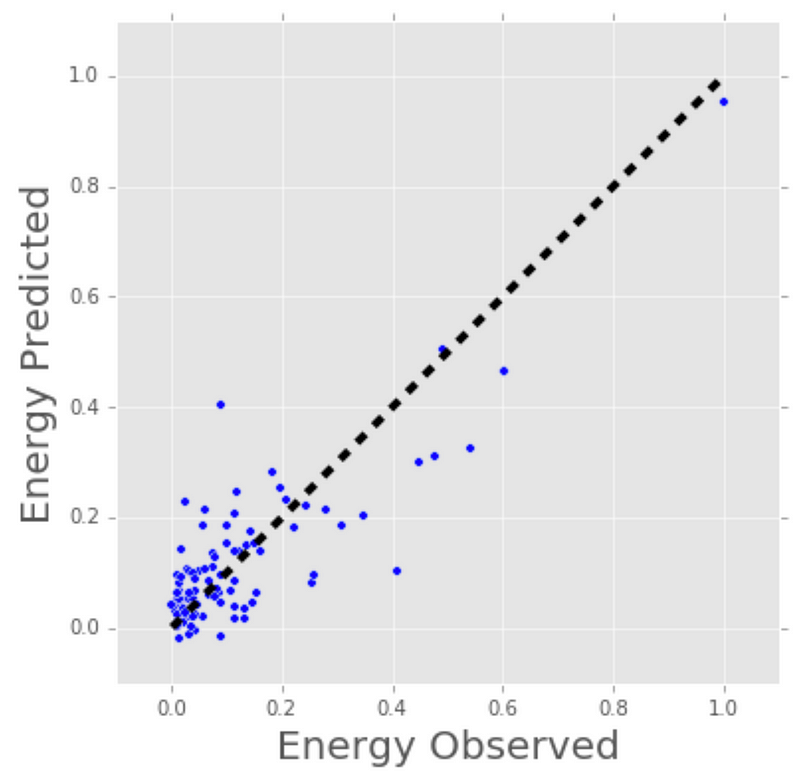
Regression
techniques run the gamut from simple (like linear regression) to
complex (like regularized linear regression, polynomial regression,
decision trees and random forest regressions, neural nets, among
others). But don’t get bogged down: start by studying simple linear
regression, master the techniques, and move on from there.
Classification
Another
class of supervised ML, classification methods predict or explain a
class value. For example, they can help predict whether or not an online
customer will buy a product. The output can be yes or no: buyer or not
buyer. But classification methods aren’t limited to two classes. For
example, a classification method could help to assess whether a given
image contains a car or a truck. In this case, the output will be 3
different values: 1) the image contains a car, 2) the image contains a
truck, or 3) the image contains neither a car nor a truck.
The
simplest classification algorithm is logistic regression — which makes
it sounds like a regression method, but it’s not. Logistic regression
estimates the probability of an occurrence of an event based on one or
more inputs.
For
instance, a logistic regression can take as inputs two exam scores for a
student in order to estimate the probability that the student will get
admitted to a particular college. Because the estimate is a probability,
the output is a number between 0 and 1, where 1 represents complete
certainty. For the student, if the estimated probability is greater than
0.5, then we predict that he or she will be admitted. If the estimated
probabiliy is less than 0.5, we predict the he or she will be refused.
The
chart below plots the scores of previous students along with whether
they were admitted. Logistic regression allows us to draw a line that
represents the decision boundary.
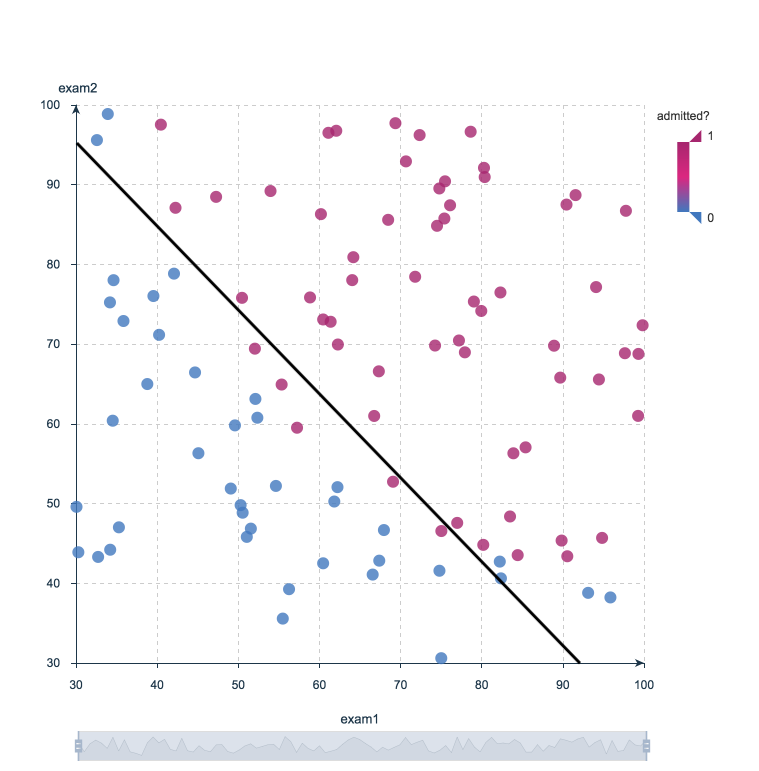
Because
logistic regression is a linear model, it’s a good place to start for
classification. As you progress, you can dive into non-linear
classifiers such as decision trees, random forests, support vector
machines, and neural nets, among others.
Clustering
With
clustering methods, we get into the category of unsupervised ML because
their goal is to group or cluster observations that have similar
characteristics. Clustering methods don’t use output information for
training, but instead let the algorithm define the output. In clustering
methods, we can only use visualizations to inspect the quality of the
solution.
The
most popular clustering method is K-Means, where “K” represents the
number of clusters that the user chooses to create. (Note that there are
various techniques for choosing the value of K, such as the elbow
method.)
Roughly, what K-Means does with the data points:
- Randomly chooses K centers within the data.
- Assigns each data point to the closest of the randomly created centers.
- Re-computes the center of each cluster.
- If centers don’t change (or change very little), the process is finished. Otherwise, we return to step 2. (To prevent ending up in an infinite loop if the centers continue to change, set a maximum number of iterations in advance.)
The
next plot applies K-Means to a data set of buildings. Each column in
the plot indicates the efficiency for each building. The four
measurements are related to air conditioning, plugged-in equipment
(microwaves, refrigerators, etc…), domestic gas, and heating gas. We
chose K=2 for clustering, which makes it easy to interpret one of the
clusters as the group of efficient buildings and the other cluster as
the group of inefficient buildings. To the left you see the location of
the buildings and to right you see two of the four dimensions we used as
inputs: plugged-in equipment and heating gas.
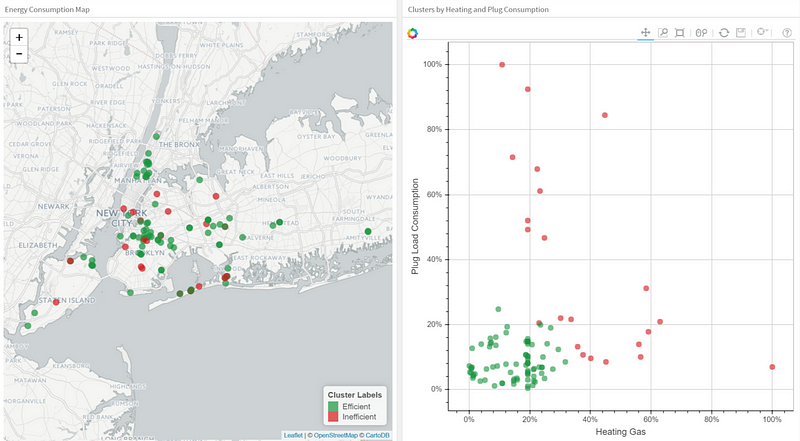
As
you explore clustering, you’ll encounter very useful algorithms such as
Density-Based Spatial Clustering of Applications with Noise (DBSCAN),
Mean Shift Clustering, Agglomerative Hierarchical Clustering,
Expectation–Maximization Clustering using Gaussian Mixture Models, among
others.
Dimensionality Reduction
As
the name suggests, we use dimensionality reduction to remove the least
important columns from a data set. In practice, I often see data sets
with hundreds or even thousands of columns (also called features), so
reducing the total number is vital. For instance, images can include
thousands of pixels, not all of which matter to your analysis. Or when
testing microchips within the manufacturing process, you might have
thousands of measurements and tests applied to every chip, many of which
provide redundant information. In these cases, you need dimensionality
reduction algorithms to make the data set manageable.
The
most popular dimensionality reduction method is Principal Component
Analysis (PCA), which reduces the dimension of the feature space by
finding new vectors that maximize the linear variation of the data. PCA
can reduce the dimension of the data dramatically and without losing too
much information when the linear correlations of the data are strong.
(And in fact you can also measure the actual extent of the information
loss and adjust accordingly.)
Another
popular method is t-Distributed Stochastic Neighbor Embedding (t-SNE),
which does non-linear dimensionality reduction. People typically use
t-SNE for data visualization, but you can also use it for machine
learning tasks like reducing the feature space and clustering, to
mention just a few.
The
next plot shows an analysis of the MNIST database of handwritten
digits. MNIST contains thousands of images of digits from 0 to 9, which
researchers use to test their clustering and classification algorithms.
Each row of the data set is a vectorized version of the original image
(size 28 x 28 = 784) and a label for each image (zero, one, two,
three, …, nine). Note that we’re therefore reducing the dimensionality
from 784 (pixels) to 2 (dimensions in our visualization). Projecting to
two dimensions allows us to visualize the high-dimensional original data
set.
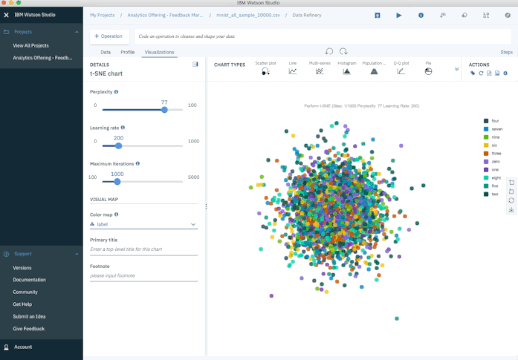
Ensemble Methods
Imagine
you’ve decided to build a bicycle because you are not feeling happy
with the options available in stores and online. You might begin by
finding the best of each part you need. Once you assemble all these
great parts, the resulting bike will outshine all the other options.
Ensemble
methods use this same idea of combining several predictive models
(supervised ML) to get higher quality predictions than each of the
models could provide on its own. For example, the Random Forest
algorithms is an ensemble method that combines many Decision Trees
trained with different samples of the data sets. As a result, the
quality of the predictions of a Random Forest is higher than the quality
of the predictions estimated with a single Decision Tree.
Think
of ensemble methods as a way to reduce the variance and bias of a
single machine learning model. That’s important because any given model
may be accurate under certain conditions but inaccurate under other
conditions. With another model, the relative accuracy might be reversed.
By combining the two models, the quality of the predictions is balanced
out.
Neural Networks and Deep Learning
In
contrast to linear and logistic regressions which are considered linear
models, the objective of neural networks is to capture non-linear
patterns in data by adding layers of parameters to the model. In the
image below, the simple neural net has four inputs, a single hidden
layer with five parameters, and an output layer.
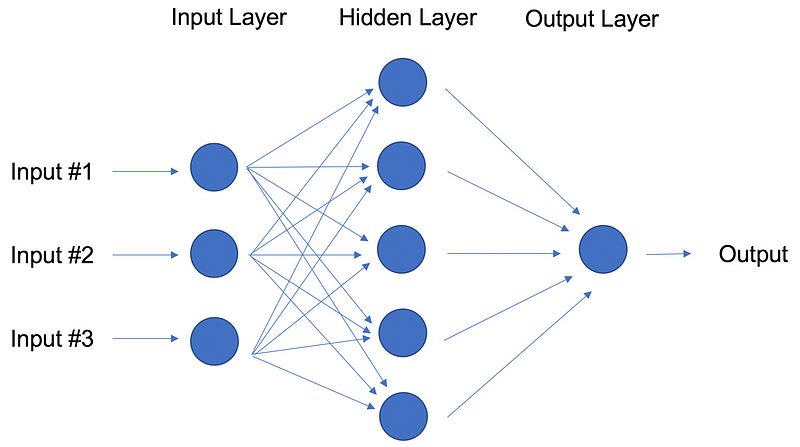
In
fact, the structure of neural networks is flexible enough to build our
well-known linear and logistic regression. The term Deep learning comes
from a neural net with many hidden layers (see next Figure) and
encapsulates a wide variety of architectures.
It’s
especially difficult to keep up with developments in deep learning, in
part because the research and industry communities have doubled down on
their deep learning efforts, spawning whole new methodologies every day.
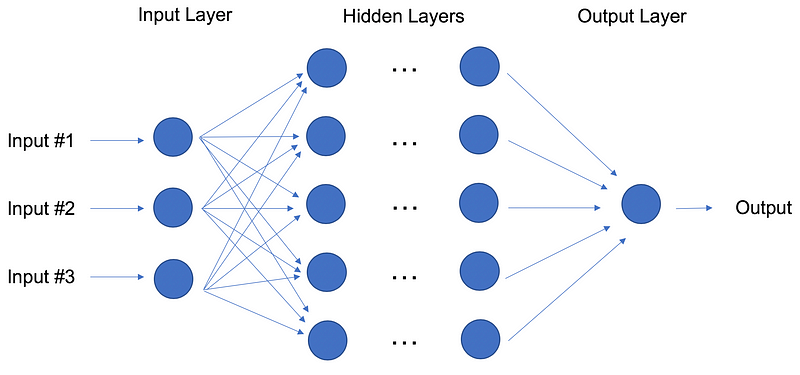
For
the best performance, deep learning techniques require a lot of
data — and a lot of compute power since the method is self-tuning many
parameters within huge architectures. It quickly becomes clear why deep
learning practitioners need very powerful computers enhanced with GPUs
(graphical processing units).
In
particular, deep learning techniques have been extremely successful in
the areas of vision (image classification), text, audio and video. The
most common software packages for deep learning are Tensorflow and PyTorch.
Transfer Learning
Let’s
pretend that you’re a data scientist working in the retail industry.
You’ve spent months training a high-quality model to classify images as
shirts, t-shirts and polos. Your new task is to build a similar model to
classify images of dresses as jeans, cargo, casual, and dress pants.
Can you transfer the knowledge built into the first model and apply it
to the second model? Yes, you can, using Transfer Learning.
Transfer
Learning refers to re-using part of a previously trained neural net and
adapting it to a new but similar task. Specifically, once you train a
neural net using data for a task, you can transfer a fraction of the
trained layers and combine them with a few new layers that you can train
using the data of the new task. By adding a few layers, the new neural
net can learn and adapt quickly to the new task.
The
main advantage of transfer learning is that you need less data to train
the neural net, which is particularly important because training for
deep learning algorithms is expensive in terms of both time and money
(computational resources) — and of course it’s often very difficult to
find enough labeled data for the training.
Let’s
return to our example and assume that for the shirt model you use a
neural net with 20 hidden layers. After running a few experiments, you
realize that you can transfer 18 of the shirt model layers and combine
them with one new layer of parameters to train on the images of pants.
The pants model would therefore have 19 hidden layers. The inputs and
outputs of the two task are different but the re-usable layers may
be summarizing information that is relevant to both, for example aspects
of cloth, fasteners, and shape.
Transfer
learning has become more and more popular and there are now many solid
pre-trained models available for common deep learning tasks like image
and text classification.
Reinforcement Learning
Imagine
a mouse in a maze trying to find hidden pieces of cheese. The more
times we expose the mouse to the maze, the better it gets at finding the
cheese. At first, the mouse might move randomly, but after some time,
the mouse’s experience helps it realize which actions bring it closer to
the cheese.
The
process for the mouse mirrors what we do with Reinforcement Learning
(RF) to train a system or a game. Generally speaking, RL is a machine
learning method that helps an agent learn from experience. By recording
actions and using a trial-and-error approach in a set environment, RF
can maximize a cumulative reward. In our example, the mouse is the agent
and the maze is the environment. The set of possible actions for the
mouse are: move front, back, left or right. The reward is the cheese.
You
can use RF when you have little to no historical data about a problem,
because it doesn’t need information in advance (unlike traditional
machine learning methods). In a RF framework, you learn from the data as
you go. Not surprisingly, RF is especially successful with games,
especially games of “perfect information”
like chess and Go. With games, feedback from the agent and the
environment comes quickly, allowing the model to learn fast. The
downside of RF is that it can take a very long time to train if the
problem is complex.
Just
as IBM’s Deep Blue beat the best human chess player in 1997, AlphaGo, a
RF-based algorithm, beat the best Go player in 2016. The current
pioneers of RF are the teams at DeepMind in the UK. More on AlphaGo and
DeepMind here.
On
April, 2019, the OpenAI Five team was the first AI to beat a world
champion team of e-sport Dota 2, a very complex video game that the
OpenAI Five team chose because there were no RF algorithms that were
able to win it at the time. The same AI team that beat Dota 2’s champion
human team also developed a robotic hand that can reorient a block.
Read more about the OpenAI Five team here.
You
can tell that Reinforcement Learning is an especially powerful form of
AI, and we’re sure to see more progress from these teams, but it’s also
worth remembering the method’s limitations.
Natural Language Processing
A
huge percentage of the world’s data and knowledge is in some form of
human language. Can you imagine being able to read and comprehend
thousands of books, articles and blogs in seconds? Obviously, computers
can’t yet fully understand human text but we can train them to do
certain tasks. For example, we can train our phones to autocomplete our
text messages or to correct misspelled words. We can even teach a
machine to have a simple conversation with a human.
Natural
Language Processing (NLP) is not a machine learning method per se, but
rather a widely used technique to prepare text for machine learning.
Think of tons of text documents in a variety of formats (word, online
blogs, ….). Most of these text documents will be full of typos, missing
characters and other words that needed to be filtered out. At the
moment, the most popular package for processing text is NLTK (Natural Language ToolKit), created by researchers at Stanford.
The
simplest way to map text into a numerical representation is to compute
the frequency of each word within each text document. Think of a matrix
of integers where each row represents a text document and each column
represents a word. This matrix representation of the word frequencies is
commonly called Term Frequency Matrix (TFM). From there, we can create
another popular matrix representation of a text document by dividing
each entry on the matrix by a weight of how important each word is
within the entire corpus of documents. We call this method Term
Frequency Inverse Document Frequency (TFIDF) and it typically works
better for machine learning tasks.
Word Embeddings
TFM
and TFIDF are numerical representations of text documents that only
consider frequency and weighted frequencies to represent text documents.
By contrast, word embeddings can capture the context of a word in a
document. With the word context, embeddings can quantify the similarity
between words, which in turn allows us to do arithmetic with words.
Word2Vec
is a method based on neural nets that maps words in a corpus to a
numerical vector. We can then use these vectors to find synonyms,
perform arithmetic operations with words, or to represent text documents
(by taking the mean of all the word vectors in a document). For
example, let’s assume that we use a sufficiently big corpus of text
documents to estimate word embeddings. Let’s also assume that the words king, queen, man and woman are part of the corpus. Let say that vector(‘word’) is the numerical vector that represents the word ‘word’. To estimate vector(‘woman’), we can perform the arithmetic operation with vectors:
vector(‘king’) + vector(‘queen’) — vector(‘man’) ~ vector(‘woman’)
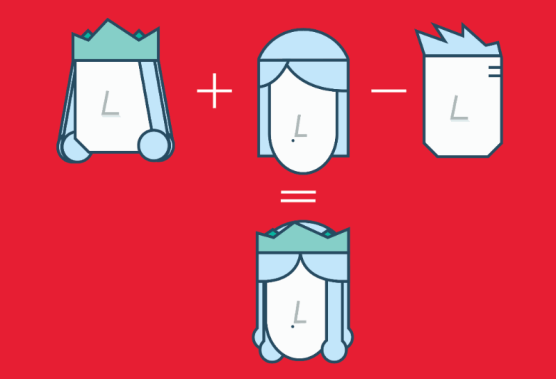
Word
representations allow finding similarities between words by computing
the cosine similarity between the vector representation of two words.
The cosine similarity measures the angle between two vectors.
We
compute word embeddings using machine learning methods, but that’s
often a pre-step to applying a machine learning algorithm on top. For
instance, suppose we have access to the tweets of several thousand
Twitter users. Also suppose that we know which of these Twitter users
bought a house. To predict the probability of a new Twitter user buying a
house, we can combine Word2Vec with a logistic regression.
You
can train word embeddings yourself or get a pre-trained (transfer
learning) set of word vectors. To download pre-trained word vectors in
157 different languages, take a look at FastText.
Summary
I’ve
tried to cover the ten most important machine learning methods: from
the most basic to the bleeding edge. Studying these methods well and
fully understanding the basics of each one can serve as a solid starting
point for further study of more advanced algorithms and methods.
There
is of course plenty of very important information left to cover,
including things like quality metrics, cross validation, class imbalance
in classification methods, and over-fitting a model, to mention just a
few. Stay tuned.
No comments:
Post a Comment